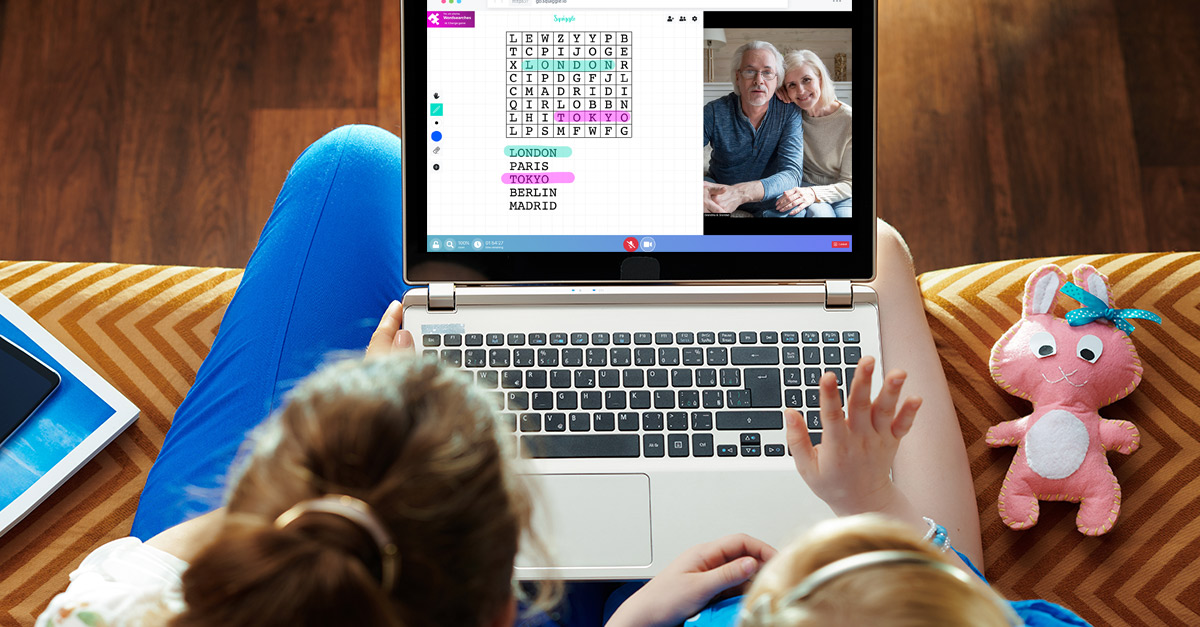Top ten tips to keep kids engaged in video calls
Read on for our top ten tips for getting kids connected - stress-free - with those they love.

Top ten tips to keep kids engaged in video calls*
* And see less of Grandad’s chin
“Jamie, tell Grandad about being the caterpillar in your school assembly! Jamie? The caterpillar… tell Grandad… in your assembly…? Jamie! Grandad can see you picking your nose! Grandad, Jamie can still only see YOUR CHIN! YES YOUR CHIN! Wait! Jamie, don’t walk off when Grandad’s chin is talking to you!! No Grandad, the cat hasn’t got his tongue he just doesn’t like video calls! Grandad, move the camera off the ceiling…”
Familiar? Video calls and kids… we’ve been there… many an iPad or laptop nearly got thrown out of the window too. The stress of trying to keep kids connected with their families, the stress of technology, keeping them engaged once everyone’s finally figured out how to ‘un-mute’ themselves… and tech is meant to make our lives easier, right?
Well, the good news is… it can! Read on for our top ten tips for getting kids connected virtually with those they love.
1. Think about the ‘who, when and where’
✔️ Keep it one-to-one
Video calling might be mainstream these days but there’s a reason why “Zoom anxiety” and “Zoom fatigue” are now buzzwords. Group video calls are hard enough for us grownups, but for kids – who are still learning key communication skills – it can result in a disjointed, overwhelming and self-conscious experience. Keeping it one-to-one keeps it simple and easy. And if they’re new to video calling, make sure they’ve practiced with an adult they know really well first.
✔️ Pick the right time
To avoid the “deflated-grandparent-uninterested-child” scenario, it’s a good idea to pick the time when a child will be at their most receptive. So, if you’ve squeezed Grandma in for 5pm once they’re back from after-school club, think again. Kids’ concentration and energy levels wane throughout the day but, unlike adults, they haven’t necessarily mastered the skill yet of covering this up. As a result they’re more likely to walk off, not be able to think what to say, “play up” and experience screen-fatigue brain fog. Choose a time when you know they’re well rested, a weekend morning perhaps?
✔️ Ensure a quiet, comfy space
Kids are curious little beings, hence they’re easily distracted with what’s going on around them. So when their little brother has just squawked at them like a pterodactyl while dressed as a Martian – or Mum’s on the phone to the double-glazing company – it can be hard to stay tuned to Auntie’s questions about what they had for lunch yesterday. Make sure they have a quiet room or space and a comfy place to sit where there won’t be interruptions.
2. Know thy tech
Whatever platform you’re using, consider a practice run first, adult to adult (we promise this will actually save time and sanity in the long-run!). It’s been said by childhood development experts that a reasonable attention span for a child is two to three minutes per year for their age, so if a six year old has spent the first fifteen minutes of the video call sitting nicely while you’re stressing how to use the platform, that’s their attention span pretty much spent!
3. Make sure they can see you and hear you
This may sound obvious but kids don’t always tell you when you’re not on-screen or if they can’t hear you! And by the time you’ve realized, their attention has drifted and lego is calling. Whatever platform you’re using, always check your camera is on, your face can be seen and your ‘mute’ button is off, then ask ‘“Can you see me ok? Can you hear me ok?”.
4. Start with sharing a snack
Kids need brainpower, kids loooove snacks and eating is a social experience. Both child and adult on the call can have the same snack at the ready so they can enjoy it together and it’s a great way to get conversation flowing. Plus a favorite snack can be a great incentive to do the call and it stops kids getting hangry – win win!
5. Warm up with easy questions
Kids aren’t natural talkers and can be quickly overstimulated when they first land on a video call, so try asking them things that don’t require a lot of thought. Starting with something relevant to their world in the moment (perhaps it’s raining outside their window, or you can see the clock on their kitchen wall is a different time to where you are in the world, or the teddy they’re holding, or a new jumper they’re wearing) then slowly build the conversation from there.
6. Keep it regular, keep it short
Kids prefer schedules to spontaneous demands, as they like to predict what’s coming and feel a sense of control. So having a short regular video call slot that they can look forward to and mentally prepare for will mean they’re not caught off guard. If it’s with the same person on a regular basis, each can give the other a little challenge for the next call “What autumn colours did you see on the way to school?” – this keeps conversations authentic and ensures both child and adult feel plugged into each other’s lives.
Start by keeping calls short and sweet (two to three minutes per year of their age, max). Whatever you do, don’t let the call drift until they’re bored – if you start noticing their attention waning it’s best to lovingly end the call, as humans we judge experiences by how they end, so it’s best to leave them wanting more!
7. Do drawing games together
It’s well proven that kids relax and open up more if they combine talking with simple drawing games. You could create your own games with pen and paper, or better still use a platform like Squiggle that’s already set up with pen-to-paper games in a virtual format: from hangman to creating pictures out of each other’s squiggles, there’s no end to the interactive creative play you can have.
8. Try a scavenger hunt
They’re not feeling chatty today? Kids love a scavenger hunt so set them the challenge of finding a few things around the house to show you on-screen as quickly as they can: from a wooden spoon, to Mum’s slipper, to the cat, to their favorite teddy, kids love it and these objects often then spark conversation!
9. Always use a trusted platform
Keeping children safe online is vital and one way of doing this is to make sure you only use video call platforms that offer a safe, private space that uses end-to-end-encryption for all video and audio data (this means only the people participating on the video call can see or hear the call). Also for young children, make sure the platform has full host / adult control of session access.
10. Let kids know before time’s up
Nearly time to say goodbye? Don’t leave ‘em hanging! It can be hard for kids to say goodbye to the people they love without a hug, and whereas you might know the call is coming to an end, they might not. Giving children the indication that there’s only a few minutes left and asking them what they’d like to do or show you on the next call, will help establish that this is regular time with someone they love that they can rely on and look forward to.
If you liked this post and want more inspiration, tips and updates from Squiggle just hit ‘Like’ on our Squiggle Facebook page and follow us on Twitter and Instagram. You can also sign up to our regular newsletter in the footer below.
